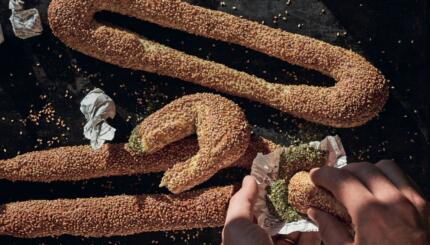Roasted Beets with Cilantro-Basil Pesto
Beets are a symbolic food eaten on Rosh Hashanah.
On Rosh Hashanah, beets, whose Aramaic name “silka” is similar to the Hebrew “salak” — go away — are eaten to express the hope that our enemies disappear.
When is Rosh Hashanah 2018? Click here to find out.
Ingredients
1/2 teaspoon salt
1/2 cup olive oil
1/4 cup parmesan cheese (or nutritional yeast, if making pareve)
1/4 cup pine nuts*
2 cloves garlic
1 packed cup cilantro leaves, washed and dried
2 packed cups basil leaves, washed and dried
2 bunches medium-sized beets, scrubbed and ends and tops removed
Directions
Preheat oven to 400 degrees. Wrap individual beets in foil and use a fork to pierce a few holes into each foil-wrapped beet. Place beets on a baking sheet and roast in the oven until a knife easily pierces through the beets, about 40 minutes.
Allow beets to rest until cool to the touch, then unwrap the beets and use a paper towel rub off the skin, exposing the bright jewel-toned flesh. Slice beets into 1/4-inch circles and arrange in a bowl or on a platter. Drizzle with cilantro-basil pesto.
To Make Pesto
Place all ingredients except the olive oil into a food processor and blend until a thick paste forms. Then, with the food processor running, slowly drizzle in the olive oil, blending until smooth. Spoon over beets and store any extra pesto in an airtight container in the fridge for up to a week.
*Some people avoid eating nuts on the high holidays–if that is your custom, you can omit them from this recipe.
Rosh Hashanah
Pronounced: roshe hah-SHAH-nah, also roshe ha-shah-NAH, Origin: Hebrew, the Jewish new year.


